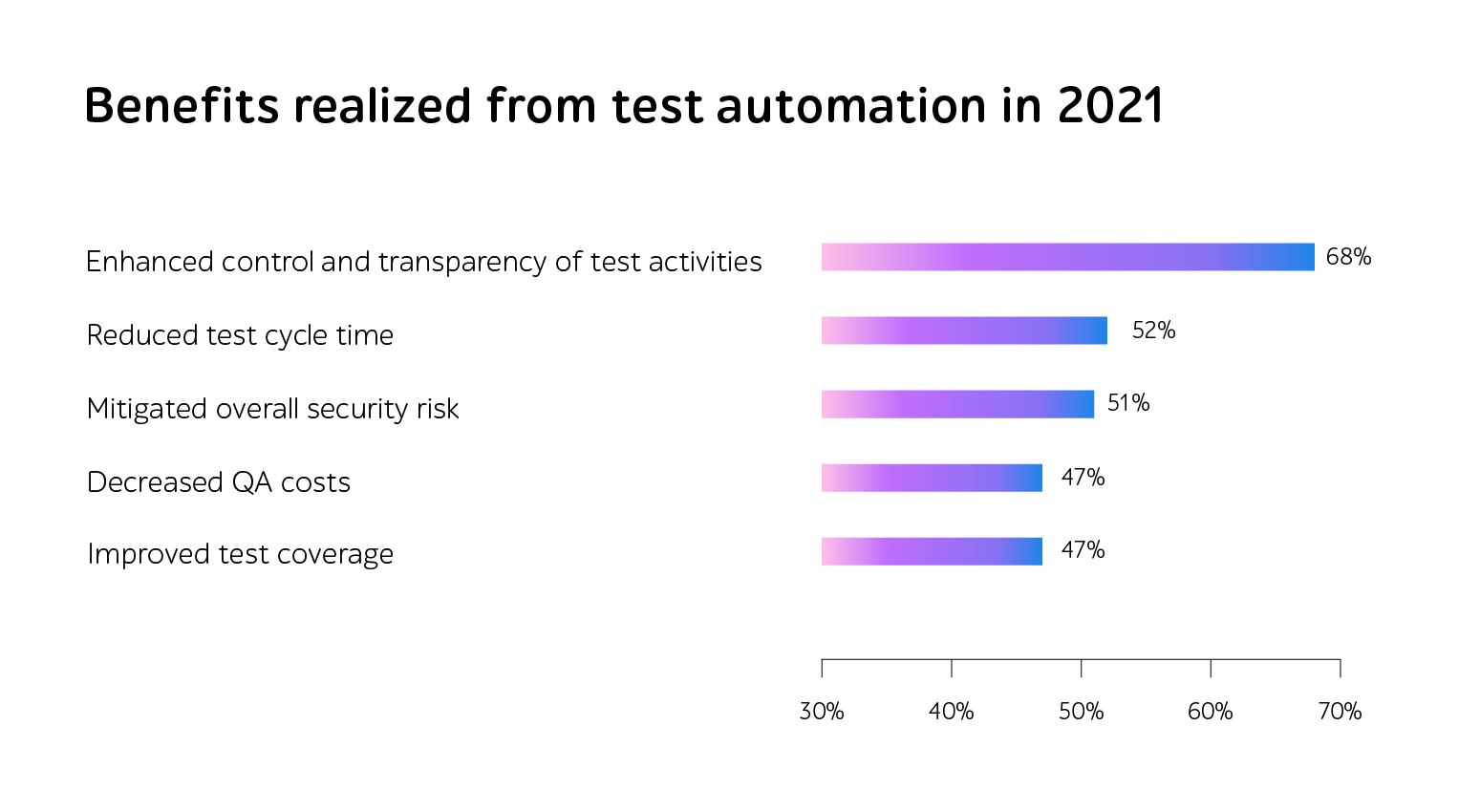
Test automation: 3 core activities to keep pace with dynamic software changes
Three words. Quality at speed. That’s what companies look for when there is a need to maintain the pace of constantly updating software and remain competitive.
To achieve that, we have 2 words. Test automation helping to ensure high software quality faster and meet customers’ needs that change as quickly as the apps themselves.
According to the World Quality Report 2021-22, IT executives automate only 15% and 20% of all tests (providing them with better KPIs, of course).
But why not 50% or 70% of all tests?
In the article, learn when companies apply automated testing, how it helps keep pace with ever-evolving IT solutions, and what activities are the core to fine-tune test automation QA processes.
Why do forward-looking companies choose test automation?
Today’s lightning-fast rhythm of life requires rapid decision-making and the same “faster-faster-faster!” pace of delivering IT products to the market. It’s okay.
To keep up with this rush, companies introduce test automation.
- Firstly, when it comes to large-scale applications with a huge number of functions that are tested regularly.
- Secondly, test automation is essential during long-term projects with frequent changes.
- And finally, automated testing is vital when releasing software often.
However, to reach the desired outcomes within the test automation framework, it is necessary to begin by analyzing business objectives, budget, allocated time, and the software itself well in advance. Then the organization has a better chance to build an effective QA strategy with test automation being the focal point.
According to the World Quality Report 2021-22, surveyed companies with test automation at the core of their business strategies received a range of competitive advantages, including enhanced control and transparency of test activities, reduced test cycle time, decreased QA costs, and others.
Source: World Quality Report 2020-21
Another interesting question is, “Why do companies need to change their applications so often?” The problem is that customers’ behavior isn’t permanent. To adjust to all end-user needs, organizations look for the strategies that allow making modifications as well as testing them in the shortest possible time without compromising the quality.
3 core test automation activities to release high-quality software
Finding the right approach to applying automated testing is the first step to achieving desired business outcomes. Introducing key test automation activities helps boost efficiency and set up QA processes.
1. Striking a balance between manual and automated testing
Switching completely to test automation is sometimes not the only way out, and for particular projects, 100% automation is just a widespread myth.
For example, many aspects of UX design require QA engineers to test them manually to understand how easy it is for end users to register on the website. Here, implementing test automation is ineffective, as the main focus isn’t on the speed but rather on the product usability.
However, there are types of tests that are better to automate to accelerate the testing process. Such tests include:
- Repetitive tests running on every build or release (e.g., smoke, regression)
- Tests on different configurations (e.g., multiple operating systems or browsers)
- Tests that use the same script but various or dynamic data for each run (e.g., data-driven tests)
- Tests that can be conducted at night (e.g., time-consuming tests)
- And many more.
According to State of Testing Report 2021, companies automate functional and regression testing (75%), unit testing (43%), load and stress testing (43%).
Thus, to build an effective QA process, a company needs to find the golden mean — wisely implement test automation and complement it by manual testing to obtain quality software.
2. Choosing the right test automation tools
Building a solid test automation process involves multiple factors to bear in mind, and selecting the appropriate test automation tools is one of them.
When the company has a clear plan for the project with defined business goals, the next step is to choose the correct instruments to do the magic!
As the pool of tools is ample, it’s better to start with analyzing critical components:
- Platforms — discover whether the tool supports various platforms (web and mobile apps, desktop browsers, databases) or run only at a particular one.
- Programming languages — make sure that the tool supports languages the QA team is going to use and matches the development stack.
- Budget — find out in advance what costs the instrument entails being ready for additional expenses to support it in the future.
- Project requirements — understanding the list of requirements and the problem that QA engineers need to fix with the software to opt for the most suitable tool.
In case your QA team is strong enough, why not design its test automation framework and create a custom tool to fine-tune and boost the efficiency of QA processes.
3. Polishing DevOps processes with test automation at the core
According to State of DevOps Report 2021, 42% of companies apply test automation within DevOps which provides teams with confidence in mitigated QA risks, reduced downtime, and facilitated pace of changes.
As DevOps favors continuous integration and continuous development, there is a strong need for continuous testing. Being a time-consuming and tedious process, continuous testing can’t dispense with test automation.
Thus, automated testing helps speed up QA processes, increase project flexibility, and gain more benefits within DevOps practices:
- Accelerating velocity without sacrificing IT solution quality
- Enhancing reliability via complete test automation coverage
- Improving user satisfaction through continuous software updates based on their feedback.
A well-designed test automation framework in DevOps contributes to fixing bugs at the initial SDLC stages resulting in delivering a faultless product to the IT market.
Bottom line
The IT world is full of changes, the same is true for software development and customers’ behavior patterns. To respond to the global uncertainty and meet constant modifications of IT products with confidence, companies rely on test automation.
Alongside maintaining business continuity, it speeds up time to market, reduces QA costs, QA risks, etc. However, to benefit even more, introduce core test automation activities to fine-tune QA processes — find the balance between manual and automated testing, apply the right test automation tools, and set up DevOps processes within the project.
In case you want to implement a robust test automation strategy, reach out to a1qa’s experts to get professional support.









